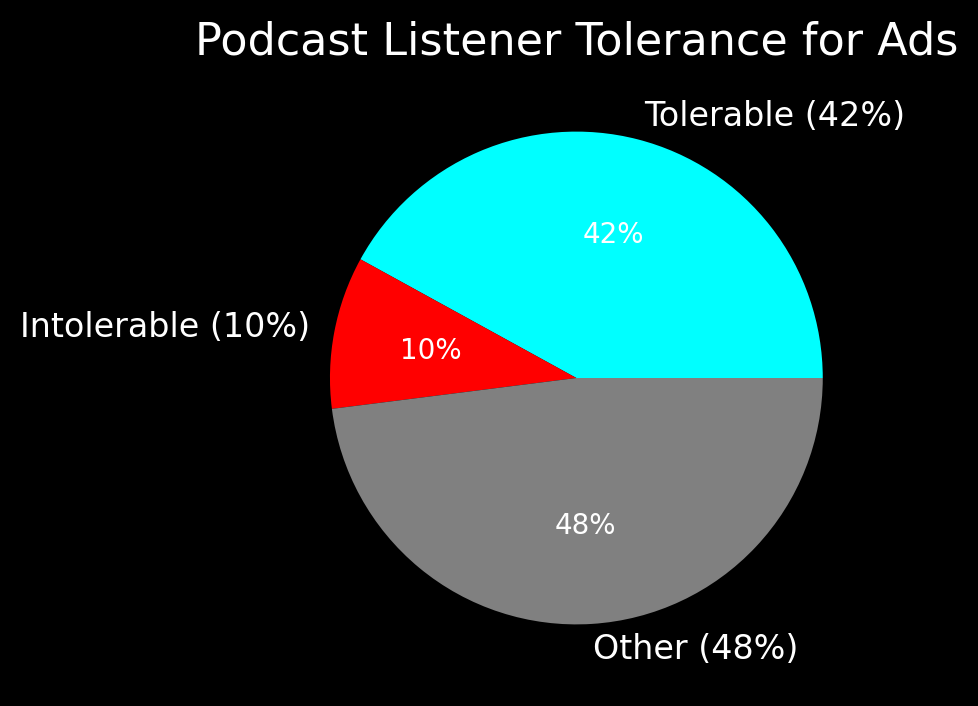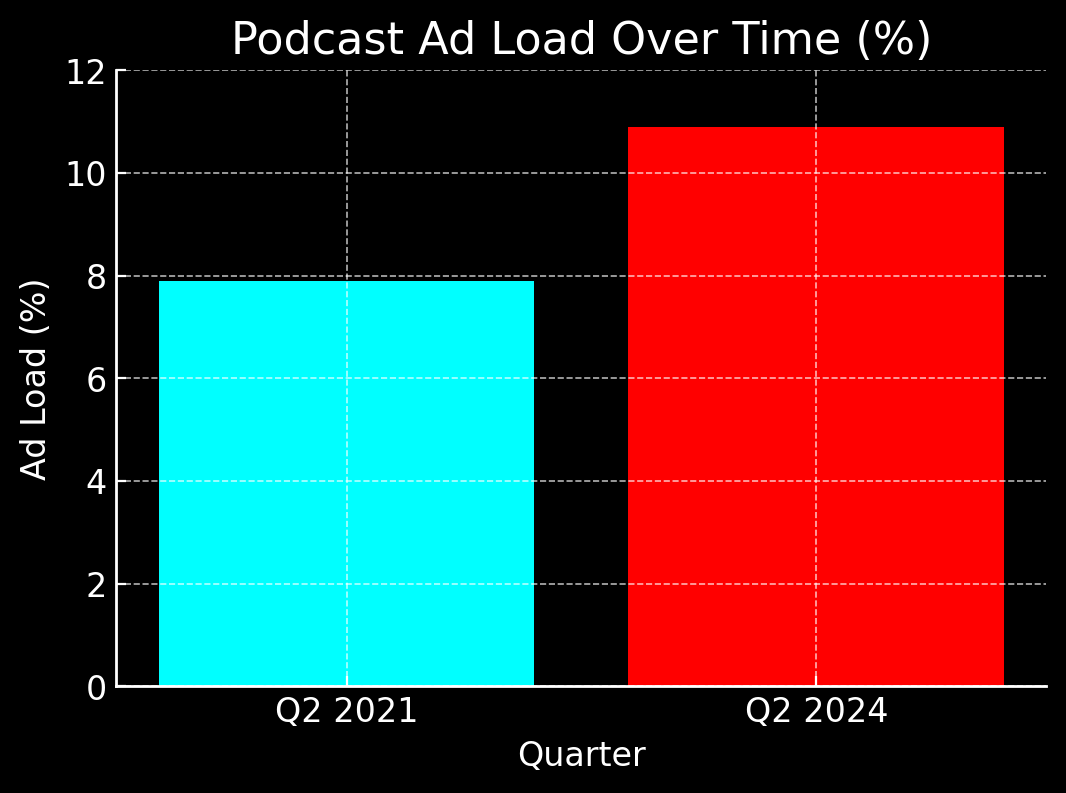BloodyFM Blog
The Power of Podcast Advertising: The 2025 Guide for Brands Looking to Connect with Engaged Audiences

BloodyFM Blog / Updated: April 09, 2025
Podcast advertising has become one of the most effective digital marketing strategies for brands looking to connect with highly engaged and niche audiences. With podcast listenership continuing to grow, brands that invest in this medium can benefit from increased brand awareness, audience trust, and strong return on investment (ROI). This article will explore why podcast advertising is so effective, the different types of podcast ads, and best practices for launching a successful podcast ad campaign.
Why Podcast Advertising Works
Engaged Listeners
Unlike traditional radio, where listeners often tune out commercials, podcast audiences are actively engaged. Since most people listen to podcasts while commuting, exercising, or working, they are less likely to skip ads compared to other digital advertising formats. This level of engagement ensures that your brand’s message is heard and absorbed by potential customers.
Additionally, podcast listeners tend to be loyal to their favorite shows and hosts. When an advertisement is read by a host that the audience trusts, it comes across as a recommendation rather than a disruptive ad. This trust factor significantly increases the chances of the listener taking action on the advertisement.
Targeted Reach
Podcasts cover almost every imaginable topic, allowing brands to reach niche audiences based on interests, demographics, and behaviors. Whether your target audience is interested in business, technology, fitness, or true crime, there is a podcast that caters specifically to them.
Unlike other forms of digital advertising that rely on broad targeting strategies, podcast advertising allows businesses to tailor their messaging to a highly specific group. This makes it easier to craft a message that resonates with listeners, increasing the likelihood of conversion.
High Retention Rates
Many podcast listeners consume entire episodes, including ad placements, increasing the likelihood of message retention compared to banner ads or social media promotions. Unlike short-form content on social media, podcasts often run for 30 minutes to an hour, giving advertisers an extended opportunity to engage their audience.
Studies have shown that listeners recall podcast ads more effectively than other digital ads. Since they are usually presented in an engaging, storytelling format, they become part of the listener’s experience rather than an interruption. This leads to higher retention and a greater impact.
Trust and Authenticity
Host-read ads, which are the most common type, feel more organic and authentic, leading to higher listener trust and conversion rates. Because podcast hosts often personally endorse the products they advertise, the recommendation feels more genuine.
This trust is especially valuable in industries where credibility is key, such as health, finance, and technology. When a well-known podcast host talks about their personal experience using a product or service, it carries much more weight than a standard commercial.
Strong ROI and Measurable Performance
Many podcast ads drive measurable conversions through promo codes, custom landing pages, and direct response campaigns. Brands can track how many customers use a specific promo code or visit a unique URL mentioned in the ad, making it easy to gauge effectiveness.
Because of the high engagement rates and strong audience trust, podcast ads often deliver a better return on investment compared to traditional digital ads. Many companies find that their customer acquisition costs are lower and that customers acquired through podcasts tend to be more loyal.
Types of Podcast Ads
Pre-Roll Ads
These ads play at the beginning of an episode. They capture the listener’s attention early but might be skipped if users fast-forward through intros. However, when a host naturally integrates a pre-roll ad into their introduction, it can still be highly effective.
Pre-roll ads work best for building brand awareness. Even if listeners skip them occasionally, repeated exposure helps reinforce your brand in their minds over time.
Mid-Roll Ads
Placed in the middle of an episode, these ads tend to be the most effective because they occur when listeners are already engaged with the content. Since most people are deeply immersed in the episode by this point, they are less likely to skip ads. More on mid-roll podcast ads here.
Mid-roll ads often allow for longer storytelling, making them ideal for product demonstrations, endorsements, and in-depth brand messaging. Because they feel like a natural part of the show, they have some of the highest conversion rates.
Post-Roll Ads
Played at the end of an episode, these ads may have lower retention but can still be effective if the content is engaging enough to keep listeners tuned in. They are best suited for reinforcing a message delivered earlier in the episode.
While post-roll ads may not have the same impact as mid-roll ads, they are still useful for encouraging listeners to take action, such as visiting a website, signing up for a newsletter, or using a promo code.
Host-Read Ads
These ads are integrated naturally into the podcast, often with the host sharing personal endorsements. They feel more authentic and resonate better with audiences. Since the host personally vouches for the product, these ads carry the most credibility.
Host-read ads are particularly effective in converting listeners into customers. The more naturally the ad fits into the podcast’s content, the better the results.
Programmatic Ads
These dynamically inserted ads are targeted based on listener demographics and interests, similar to display advertising in digital marketing. They allow brands to reach a wide audience without needing to partner with specific hosts.
While programmatic ads can be cost-effective, they don’t always have the same level of trust and authenticity as host-read ads. However, they are a good option for brands looking to scale their podcast advertising campaigns.
Sponsored Episodes or Branded Content
Some brands go beyond traditional ads and collaborate with podcasters to create full sponsored episodes that incorporate their messaging seamlessly. These episodes provide an opportunity for in-depth storytelling and brand integration.
Related Article: A Quick Guide to Starting a Podcast in 2025
Sponsored episodes work well for industries that require education and detailed explanations, such as finance, healthcare, and technology. They allow brands to showcase their expertise while keeping the audience engaged.
Best Practices for Podcast Advertising Success
Choose the Right Podcast
Selecting a podcast with an audience that aligns with your target demographic is crucial for maximizing engagement and conversions. Research podcast listener demographics, engagement levels, and content style to ensure a good fit.
It’s also important to listen to episodes and evaluate the tone and authenticity of the host. A podcast that naturally aligns with your brand’s voice and values will lead to better results.
Prioritize Host-Read Ads
These ads tend to perform better than generic pre-recorded ads, as they leverage the host’s trust and authority. Listeners trust the recommendations of their favorite podcasters, making host-read ads more effective than traditional commercials.
Brands should encourage hosts to share personal stories or experiences related to the product to make the ad feel more genuine and engaging.
Keep the Message Conversational
Avoid sounding too sales-driven. Instead, focus on storytelling and how your product or service benefits listeners. The best podcast ads feel like a natural part of the conversation rather than an interruption.
Including a real-life anecdote or a humorous element can make the ad more memorable and engaging.
Podcast advertising is an invaluable tool for brands looking to build meaningful connections with engaged audiences. With the right strategy—choosing the right podcasts, leveraging host-read ads, and optimizing performance—businesses can achieve strong ROI and lasting brand recognition.
As digital audio continues to rise, now is the perfect time to explore podcast advertising as part of your marketing mix. By focusing on authenticity, audience alignment, and strategic placement, brands can maximize the impact of their podcast ad campaigns.
Podcast Marketing by the Numbers
Increase in Podcast Ad Load
Ads occupied 10.9% of podcast run times in Q2 2024, up from 7.9% in Q2 2021, according to Oxford Road and Podscribe. This indicates a growing trend of increased ad placements within podcast episodes.

Ad Revenue Per Hour Listened
Podcast ad revenue per hour of content heard by a listener has steadily increased over the years:
- 2015: $0.02
- 2021: $0.05
- 2024: $0.06
This rise reflects advertisers’ growing willingness to invest in the podcast medium.
Podcast Ad Formats and Volume
Podcast advertising has evolved significantly, with many shows incorporating more ads per episode:
- Previously, podcasts featured one or two ads per episode.
- Now, it is common for podcasts to have ads every 10 minutes.
- Some podcasts stack two or three ads per commercial break.
- A recent episode of Call Her Daddy contained eight ads across four ad slots.

Podcast Audience Tolerance for Ads
Listener tolerance for podcast ads varies, with the majority finding them acceptable:
- 42% of listeners find podcast ads “slightly annoying, but tolerable.”
- 10% of listeners describe podcast ads as “intolerable or barely tolerable.”
This suggests that while ads are generally accepted, excessive ad loads may push some listeners away.

Impact of Increasing Ad Load on Ad Effectiveness
Research from Oxford Road and Podscribe indicates that increasing ad load may have diminishing returns:
- Listener response to ads decreases as the number of ads per episode rises.
- While a single ad might not prompt a skip, listeners are more likely to skip multiple ads played consecutively.
This highlights the importance of balancing monetization with listener experience.
Industry Pressure on Podcast Monetization
The podcasting industry has faced financial pressure, leading to increased ad placements:
- Spotify spent over $1 billion acquiring podcast studios and talent but struggled to turn a profit.
- Major podcasting companies, including NPR, New York Public Radio, and Malcolm Gladwell’s Pushkin Industries, laid off staff due to weak digital ad revenues.
- Paradiso Media, a podcast production company, filed for bankruptcy in July 2024.
Podcast Ad Load vs. Other Media
Compared to other media formats, podcasts still have a relatively low ad load. According to eMarketer, traditional TV and radio tend to have a higher volume of ads per hour.
Alternative Revenue Models
Some podcasters are finding ways to monetize without relying solely on ads:
- The hosts of Celebrity Memoir Book Club focus on select partnerships instead of overloading their episodes with ads.
- They also monetize through live events and Patreon subscriptions, offering exclusive content for $5-$10 per month.
The growth of podcast advertising shows its increasing importance in digital marketing. However, the challenge lies in striking the right balance between maximizing ad revenue and maintaining a positive listener experience. As more brands invest in podcast ads, podcasters must ensure they do not alienate their audience with excessive commercial interruptions.
Frequently Asked Questions (FAQs) About Podcast Advertising in 2025
Why is podcast advertising effective?
Podcast ads are effective because listeners are highly engaged and trust the hosts. Host-read ads, in particular, feel authentic and often lead to higher conversions.
How do podcast ads compare to traditional digital ads?
Podcast ads tend to have higher retention and trust levels than traditional digital ads, with measurable ROI through promo codes and custom URLs.
What types of podcast ads are available?
Common formats include pre-roll, mid-roll, post-roll, host-read ads, programmatic ads, and sponsored or branded episodes. Each has a unique role in ad strategy.
What is a host-read ad?
It’s an ad read directly by the podcast host, often with a personal endorsement. These ads feel more natural and trustworthy, increasing listener response.
What are programmatic podcast ads?
These are dynamically inserted ads based on listener data, similar to display ads in digital marketing. They’re scalable but may feel less personal than host-read ads.
Are mid-roll ads more effective than other types?
Yes. Mid-roll ads are placed during the content, when listeners are most engaged, making them the most effective for conversions and storytelling.
How can brands measure the effectiveness of podcast ads?
Brands use promo codes, unique URLs, and direct response campaigns to track conversions, listener behavior, and ROI from podcast ad placements.
Do listeners tolerate podcast ads?
Yes, but with limits. 42% of listeners find ads tolerable, while only 10% find them intolerable. Overloading episodes with too many ads can reduce engagement.
What is the ideal number of ads per episode?
It’s best to limit ads to one or two per segment to avoid fatigue. Overloading with ads every 10 minutes can harm listener trust and retention.
What are sponsored episodes?
Sponsored or branded episodes are full podcast episodes created in collaboration with a brand. They offer in-depth storytelling and immersive brand integration.
Which industries benefit most from podcast advertising?
Podcast ads work well for tech, finance, health, fitness, and entertainment industries—especially when authenticity and trust are key to customer decision-making.
How has podcast ad load changed over time?
Podcast ad load increased from 7.9% in Q2 2021 to 10.9% in Q2 2024, reflecting rising demand from advertisers and growing monetization pressure in the industry.
What challenges does the podcast ad industry face?
Increasing ad loads can reduce effectiveness. The industry also faces profitability challenges, staff layoffs, and balancing monetization with listener experience.
Can podcasts generate revenue without ads?
Yes. Many podcasts monetize through Patreon, exclusive content, live events, and select partnerships, reducing reliance on frequent ad placements.
Is now a good time to invest in podcast advertising?
Yes. With growing audiences and high trust in hosts, now is a great time for brands to include podcast advertising in their digital marketing strategy.


